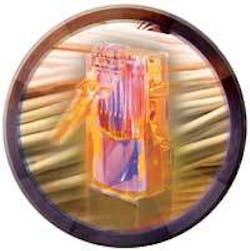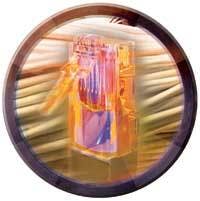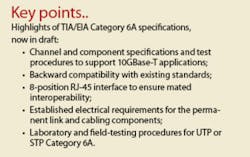Performance is everything: The standards for 10GBase-T
TIA/EIA and TSB documents will spell out specifications for running 10-GbE over Augmented Category 6 and Category 6.
The Institute of Electrical and Electronics Engineers IEEE 802.3an 10-Gigabit Ethernet (10GBase-T) standard, approved in June, is the cornerstone for defining the new physical coding and sublayer interface for 10GBase-T applications over balanced twisted-pair copper cabling systems.
The ratified standard additionally establishes signaling and interference requirements for semiconductor chips that will support 10-Gbit/sec performance. Further, the standard specifies four-connector channel electrical requirements for the following structured cabling systems: Augmented Category 6/Class EA, Class F, and Category 6/Class E. In addition, IEEE recommends users follow the specifications and guidelines established by TIA/EIA to ensure 10-Gbit/sec performance.
At the request of the IEEE 802.3 Committee, TIA/EIA has agreed to specify Augmented Category 6 (Category 6A) cabling systems and components to support 10-GbE applications over a distance of 100 meters. TIA/EIA Category 6A specifications are currently in draft document and, once ratified, will be published as ANSI/TIA/EIA-568B.2-AD10.
In addition to the Category 6A standard, TIA/EIA is also working on a Telecommunications Systems Bulletin guidelines document (TSB-155) to determine whether installed base Category 6 cabling meets the requirements of ANSI/TIA/EIA-568B.2-1 in supporting 10-GbE applications.
What’s the point?
With a ratified IEEE 802.3an 10GBase-T standard that identifies channel electrical requirements for copper cabling systems, one might question the additional need for a TIA/EIA 10GBase-T standard. The reason is that the IEEE 10GBase-T standard focuses primarily on the active equipment requirements. TIA/EIA will establish industry requirements for designing, installing, testing, and operating a new structured cabling system that supports 10-Gbit/sec performance up to 100 meters.
Using copper cabling channel requirements of the IEEE 10GBase-T ratified standard as its foundation, the TIA/EIA Category 6A standard will develop channel and component specifications (cable, connecting hardware, and cords) and test procedures to support 10GBase-T applications. In addition, the TIA/EIA Category 6A standard will ensure backward compatibility with existing ANSI/TIA/EIA standards (i.e., Category 6, 5e, 3) and will require the use of an 8-position, RJ-45 modular jack interface to ensure mated component interoperability.
Following the lead of the IEEE 802.3an standard, the TIA/EIA-568-B.2-AD10 draft standard recognizes both an unshielded twisted-pair (UTP) and a shielded twisted-pair (STP) Category 6A copper cabling system. As with the IEEE 802.3an standard, both cabling systems will need to extend the Category 6 internal electrical parameters (near-end crosstalk, far-end crosstalk, return loss, and insertion loss, among others) up to 500 MHz, as well as address the new alien crosstalk (both near-end and far-end) requirements up to 500 MHz.
In addition to specifying channel requirements, the TIA/EIA-568-B.2-AD10 standard will go above and beyond the IEEE 802.3an standard by establishing electrical requirements for the permanent link and cabling components. Permanent link requirements will facilitate field-testing of the cabling systems, while the cabling-component requirements will allow for interoperability between different cabling and connectivity vendors in the marketplace.
Similar to the channel requirement, the permanent link and cabling component electrical specifications will have internal and alien crosstalk electrical parameter requirements up to 500 MHz.
Testing, testing
Another important component of the TIA/EIA-568-B.2-AD10 standard will be the laboratory and field-testing procedures for a UTP or STP Category 6A cabling system. The TIA/EIA-568-B.2-AD10 Draft 5.0 document specifies the following key requirements for laboratory testing of alien crosstalk (near-end and far-end loss) for a cabling system:
• Use of a network analyzer with 100-Ω pair terminations;
• Frequency range from 1 to 500 MHz;
• Six-around-one cable-bundle configuration throughout the tested length;
• Cable ties placed 12 inches apart for the entire length of the bundle, except the last 3.2 feet from each end; no cable-tie-induced deformation of the bundle;
• Modeling four-connector channel configurations using the worst-case maximum and minimum configurations to determine the worst-case for different parameters;
1. Long channels with 90 meters of permanent link, 5 meters between the consolidation point and the telecommunications outlet, 10 meters of patch cords used to connect active equipment and cross-connect panels;
2. Short channels with 15 meters of permanent link, 5 meters between the consolidation point and telecommunications outlet, and a total of 4 meters of patch cords used to connect active equipment and cross-connect panels;
• Measurement of alien crosstalk (near-end and far-end loss) between all pairs of the middle disturbed cable and each pair of all adjacent cables;
• Measurement of power sum of all 24 adjacent pair cables.
Furthermore, the TIA/EIA-568-B.2-AD10 Draft 5.0 document specifies the following key requirements for field measurements of alien crosstalk (near-end and far-end loss) for a cabling system:
• The test device consists of two jacks; one jack is connected to a main test unit and the other to a remote test unit; the main test unit and the remote test unit are connected with a field tester communication channel (patch cord or link);
• Frequency range of measurement is from 1 to 500 MHz;
• For permanent link testing, alien crosstalk (near-end and far-end loss) is measured by terminating test cords with plugs that exhibit 100-Ω differential and 50-Ω common mode terminations;
• For channel testing, alien crosstalk (near-end and far-end loss) is measured in the same manner as permanent link testing, except the remote ends of the disturbed and a disturber pair are terminated with factory-constructed jacks that also include a 100-Ω differential and 50-Ω common mode termination;
• The draft standard provides the following key guidelines for field testing:
1. Only links in the same cable bundle are expected to contribute a significant amount of power-sum alien crosstalk;
2. Most of the alien near-end crosstalk loss occurs within the first 40 meters of the near end of the cabling;
3. Start testing alien near-end crosstalk using disturber links located adjacent to the disturbed link where the cables are terminated (i.e., patch panel);
4. Continue testing until the overall alien near-end crosstalk loss no longer appears to degrade, and all likely disturber links (from knowledge of the cabling topology) have been measured.
Once the TIA/EIA-568-B.2-AD10 is ratified, it will be recognized as the industry standard to ensure that Category 6A structured cabling systems and/or components can support 10-Gbit/sec data rates. Conversely, IEEE 802.3an (June 2006) will remain the industry standard for active equipment containing the physical coding, signaling, and interface characteristics to support 10-Gigabit Ethernet.
The TIA/EIA-568-B.2-AD10 standard is expected to be approved in the first quarter of 2007.
TSB-155 characterizes Cat 6
In addition to the TIA/EIA-568-B.2-AD10 draft standard, TIA/EIA is also working on a guidelines document, TSB-155, for the assessment of Category 6 cabling in support of 10-Gigabit applications. TSB-155 is intended to provide a method to assess Category 6 cabling systems’ ability to meet the extended frequencies (from 250 to 500 MHz) and additional parameters, both for channel and permanent links, necessary to support 10GBase-T applications.
As is the case with the TIA/EIA-568-B.2-AD10 Draft 10GBase-T standard, the key electrical requirement of TSB-155 is the alien crosstalk (near-end and far-end loss) for a cabling system. In its current draft form, TSB-155 states that 10GBase-T is expected to operate over channel lengths of:
• At least 37 meters of Category 6 cabling;
• Between 37 and 55 meters of Category 6 cabling depending on the alien crosstalk environment;
• More than 55 meters of Category 6 cabling with mitigation techniques.
Nonetheless, it is important to note that no matter what the cable channel length, to support 10GBase-T applications, Category 6 cabling must meet the electrical specifications of TSB-155 for internal transmission parameters (near-end crosstalk, return loss, insertion loss, far-end crosstalk, and others) up to 500 MHz, as well as alien crosstalk (near-end and far-end loss) up to 500 MHz.
The published Category 6 standard (TIA/EIA-568-B.2-1) only specifies internal electrical requirements up to 250 MHz and does not have electrical requirements for alien crosstalk. So, for a Category 6 cabling system to support 10GBase-T applications, it is subjected to the electrical specifications of TSB-155.
In other words, there are no guarantees, short of field-testing, that a Category 6 cabling system will be able to support 10GBase-T applications. Annex A of TSB-155 provides the field-testing procedures for measuring Category 6 cabling systems up to frequency ranges of 500 MHz. For alien crosstalk (near-end and far-end loss), the field measurement procedures are the same as specified in TIA/EIA-568-B.2-AD10 draft 10GBase-T standard.
From a testing strategy perspective, TSB-155 provides the following key guidelines:
• Only test links that are intended to support 10GBase-T;
• Alien crosstalk testing may be necessary if multiple cabling channels or permanent links are in close proximity to each other;.
• Test disturber links that are terminated adjacent to disturbed links on patch panels or other connecting hardware;
• The number of disturber ports to be included in the alien crosstalk calculation is dependent on the cabling topology; the power-sum alien crosstalk should be calculated and monitored until all likely disturber cables have been measured (from knowledge of the cabling topology).
Based on field-testing measurements, if a Category 6 cabling system does not meet the electrical requirements for supporting 10GBase-T applications, TSB-155 provides guidelines designed to mitigate the alien crosstalk between the disturbed pair and disturbing pairs of Category 6 channels and permanent links. In summary, Annex B of TSB-155 outlines the following mitigation actions most appropriate for individual situations:
• Use non-adjacent patch panel positions;
• Separate equipment cords and patch cords;
• Unbundle the horizontal cabling;
• Use Category 6 ScTP or Category 6A equipment cords;
• Reconfigure the cross-connect as an interconnect;
• Replace Category 6 connectors with Category 6A connectors.
Once approved, TSB-155 will be a useful guide for assessing whether an installed Category 6 cabling system can support 10GBase-T applications. Additionally, TSB-155 will provide defined mitigation procedures to minimize alien crosstalk in a cabling system. Based on the current status, TSB-155 is to be approved later this year.
Complementary documents
The ratified IEEE 802.3an 10GBase-T standard is an application standard that defines the physical coding, signaling, and sublayer interface for 10-Gbit/sec data-rate performance over balanced twisted-pair copper cabling systems. TIA/EIA will publish a Category 6A structured cabling standard that will define the channel and component (cable, connecting hardware, and cords) specifications, and test procedures (including field testing and laboratory measurement procedures) to support 10GBase-T applications. In parallel, TIA/EIA is working on a guidelines document, TSB-155, for the assessment of Category 6 cabling in support of 10-Gbit/sec applications.
The IEEE 10GBase-T and TIA/EIA Category 6A standards along with the TSB-155 guidelines will complement one another to enable the deployment of a cost-effective 10-Gbit/sec solution to meet the ever-increasing bandwidth needs of today and tomorrow.ROBERT DENNELLY is a business development manager with Panduit Corp. (www.panduit.com).


